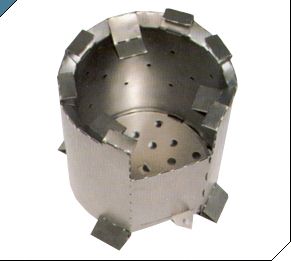
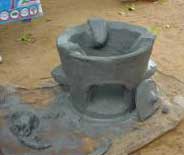

(GTZ/IFSP)
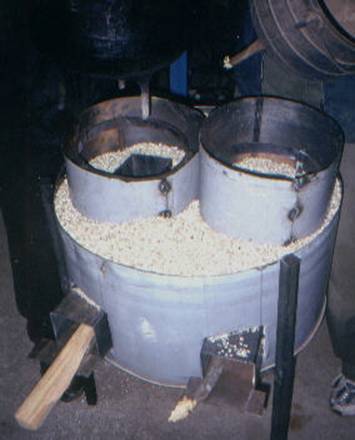
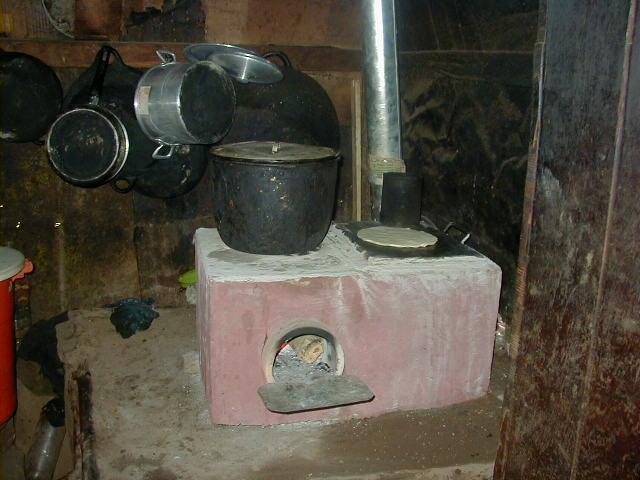
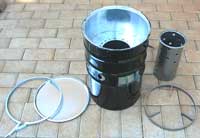
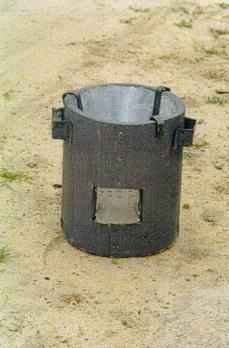
Paul J. M. Mushamba (ProBEC), Dean Still (Aprovecho) and Steve Gitonga (ITDG) on Energy Saving Stoves In Southern Africa
February 2003
Paul Mushamba, ProBEC GTZ Programme for Biomass Energy Conservation in Southern Africa
Dear All
To all who have contributed and shown interest in the above subject, here is a contribution from ProBEC.
The "How-to guide" authored by Christa Roth on clay stoves in Southern Malawi has generated a lot of interesting discussion and useful contributions by researchers and practitioners from different parts of the world. For the past 3 years GTZ, through ProBEC (Programme for Biomass Energy Conservation in Southern Africa) has been supporting interventions to improve the energy supply and utilization patterns for households and small-scale enterprises in the SADC region. This programme has yielded some useful experiences and lessons which I would like to share with you all.
1. Firstly I would like to thank Christa and Christoph for sparking this healthy debate. It affords us all an opportunity to exchange our diverse experiences, which should hopefully enhance our own understanding of the issues at play and success factors for improved biomass stoves, which in turn should lead to the improvement of the quality of life for the millions of people dependent on biomass energy for their livelihoods today.
From 10-14 March 2003, ProBEC is hosting a workshop at the Vaal Triangle Technikon just outside Johannesburg in South Africa, which brings together stove designers and implementers of improved stove projects to provide a forum for further debate and seek agreement on minimum quality standards for improved biomass stoves.
2. Dean Still is correct when he condemns high mass UNISULATED clay/mud stoves for being inefficient. I know of programmes that have promoted such stoves erroneously believing that they were efficient, only to be confronted with disastrous results. Many of us have learnt from such bad experiences, and we should continue to learn with an open mind.
3. In the BEC interventions or projects which are going on with the support of ProBEC in the different countries in Southern Africa, the clay and/or mud stove has so far taken off ahead of many others. This is measured in terms of numbers disseminated and frequency of use by the owners. In particular, households in certain districts in Malawi and Zimbabwe have accepted and adopted the clay stove quite readily.
4. ProBEC is promoting two types of mud/clay stove, that is the portable and the inbuilt stove. The former is adequately described in Christa's guide, although there are slight variations from one region/country to another mainly necessitated by the need to cater for different shapes and/or sizes of cooking pots. The in-built mud stove is insulated from the floor and kitchen walls using wood ash. Efficiency is achieved because the pot is sitting directly above and "seeing" the fire. (This is the sort of language used when training the stove builders). The pot-fire distance is also optimized to ensure maximum heat transfer, and stove builders use the figure of 18 to 20 cm as a rule of thumb. Clearance between the rim of the stove and the edge of the pot sitting in the stove equals or is less than the breath of your small finger. If a multiple-pot stove is required, it is recommended to build one with separate fire boxes for each pot in order to maintain this direct path of heat from the fire to the pot. All the above stove design features are good for not only radiative and convectional heat, but for conduction from the flue gases to the pot as well.
5. Fuelwood consumption tests done on the mud stove in one district in 2001 indicated Fuelwood savings ranging from 30-50%. Stephen Gitonga observes that fuel efficiency seems to be the only common ground between stove builders and users. Given realities encountered in the field which include low literacy levels, inavailability of equipment, time pressure and so on, rigorous scientific testing is often not feasible. We are interested to get your views as to how far the testing process can be simplified before compromising validity.
6. We are interested to learn about other low-cost insulating materials, better than wood ash. Vermiculite is available cheaply in South Africa but not in the other countries in the region. Dean mentions a list of insulators but I am not sure how cheap these are.
7. Smoke removal and reduction of harmful emissions from the kitchen are important considerations for improved biomass stoves. This is especially so considering the crucial role of a clean kitchen environment in the home-based care of HIV/AIDs patients. (The pandemic has an alarming prevalence in the region). In both Malawi and Zimbabwe, siting and positioning of the fixed mud stoves in the kitchen are done with due consideration to the prevalent wind direction for a given locality. The stove is therefore built below a small window or other aperture on the windward side of the kitchen. If a suitable opening is not in place, the stove builder has to persuade the house owner to create one. It is easier though where a new kitchen is under construction, which is the case in many parts of Zimbabwe due to the land redistribution and resettlement programme. When the stove is in operation, the emitted smoke tends to flow up the kitchen wall and out through the opening at the top of the kitchen wall. I have some photos showing the effectiveness of this method of smoke removal, but I have to reduce the pixel size first before I can mail them. If you are interested, just give me a shout.
8. Among other things combustion efficiency, and therefore emission reduction is very much a function of the moisture content of the wood used in the stove. The clay stoves being disseminated in Zimbabwe incorporate an adjoining cubicle for storage of split wood, to dry it further before eventual use in the stove. End-user practices such as proper handling of the fuel-wood and improved cooking practices are critical for the ultimate achievement of efficiency by the stove.
9. I mentioned earlier the popularity of clay/mud stoves as opposed to others such as metal ones. As a guiding principle, ProBEC does not favour one type of improved stove as opposed to another. The main consideration is that the stove should meet basic performance and operational criteria. By and large, the job of stove selection is left to the users. It would appear that clay stoves are favoured mainly because, being made of a freely occurring natural resource, they are low cost and yet they still give the advantages of a cleaner kitchen environment, consume less wood and are able to utilize heat from residual ambers. The issue of low cost cannot be overemphasized, considering that of the 2 billion people reported to be living on less than US$1/day, a substantial number is living in Africa.
10. I would not deny that a well managed open fire (3-stone fireplace) can achieve a PHU value as high as 20%. But only firewood which is above a certain critical size can be used successfully to cook on an open fire. The fire from twigs, crop stalks, maize cobs, etc. is very quickly blown away and spent before one can prepare a meal on it. Stephen Gitonga makes a similar observation in hiscontribution With the clay stove, it is possible to use twigs and some crop residues to prepare a meal to the standard which adequately meets the expectations of the users.
11. Among the stoves in our shortlist are the portable metal stove from Mali, the Turbo stove developed by Tapio Niemi of Finland, the Mulanje stove being promoted in southern Malawi, the Mud stove being used in northern Malawi and Zimbabwe, the Rocket and Eco stoves developed by Approvecho, the Shisa stove by Dawn Engineering of Swaziland and the Namibian tsotso stove. We see these as promising prototypes although some require considerable work to improve them, and as pointed out earlier, it is the users who should be the final judges.
12. In June/July 2002, the Rocket stove from Approvecho was demonstrated to households in rural villages of South Africa. They were all impressed (and so was I) with the low smoke emission from the stove and the quick cooking. However, there were a number of sticking points: one had to feed the stove with wood every few minutes, which increases the time required for tending the fire compared to other stoves; the vermiculite at the top was exposed and mothers were concerned children would temper with it; the skirt for directing hot gases to scrape the sides of the pot posed a risk of cutting the user; handles to lift the stove were missing. For me the rocket stove is very promising but these concerns from the potential end-users need to be addressed first.
13. As mentioned earlier, ProBEC is hosting a workshop on "Stove design and marketing strategies" where the developers and promoters of the improved stoves above are invited to present the technical details and operation of their products. This will be followed by a review, critique and recommendations for improvements by the other workshop participants. The major output expected from the workshop is a set of quality and performance criteria to serve as a minimum standard for biomass stoves. I would very much like to hear your views and comments about the workshop concept.
Promising Stoves Types in Southern Africa
|
|
 |
 |
 |
|
Turbo Stove (Tapio Niemi)
|
Mulanje Clay Stove (GTZ/IFSP)
|
Mud Stove Zimababwe and North Malawi
(GTZ/IFSP) |
|
 |
 |
 |
 |
|
Double Burner Rocket (Aprovecho)
|
Eco-Rocket Stove (Prolena)
|
Shisa (New Dawn)
|
Tsotso (Namibia)
|
Dean Still Aprovecho Research Center
The clay/sand stoves shown by Christa Roth and Christoph Messinger are,unfortunately, good examples of stoves that have in laboratory tests been shown to use more firewood than three stone fires. Just surrounding the firewith heavy earthen materials does not raise combustion temperatures. The mass actually lowers combustion temperatures for hours until the stove body has come up to temperature itself. The heat is diverted from its intended purpose: to cook food. Why heat up hundreds of pounds of stove body when cooking five - ten pounds of food? A three stone fire can be quicker, smokes less, uses less fuel.
Clay/sand is not insulation. This was the mistake made by the inventors of these types of stoves, including Aprovecho. Earthen material was thought to insulate around the fire but we later realized that good insulation is pockets of air in a lightweight, low conducting material. Naturally available sources include pumice rock, perlite, vermiculite, wood ash, etc.
To improve on the properly operated three stone fire requires an insulated combustion chamber which can be made from locally available materials as well. Forcing the heat to scrape against the sides of the pot is the true advantage of the good cook stove, improved heat transfer can help to save large percentages of wood. To do this without first cleaning up combustion
in an insulated combustion chamber can create more harmful emissions, however. Both hotter, cleaner combustion and improved heat transfer can easily be designed into a modern, improved ceramic cook stove.
It was a sobering experience for Aprovecho stove designers when they were
confronted with proof from university researchers that their beloved stove,
the Lorena, was not really "fuel efficient" although books published by
Aprovecho claimed the savings were 50%. Over the last 20 years the
understanding of how stoves work has grown to the point where there are
substantive grounds of common understanding. Both how to clean up combustion
and how to increase heat transfer to the pot are now generally accepted
engineering concepts.
Dr. Larry Winiarski has come up with a set of design principles that can be
used in many different stoves. Larry likes to start out discussions of stove
design by saying that there is no such thing as a Rocket stove! Stoves that
use the Rocket design principles are always different depending on use and
materials available. A mud stove and a two pot stainless steel stove with
chimney can both be Rocket stoves. Larry's design principles follow this
letter.
I believe that the fastest and most successful way to design a stove that
will be widely appreciated and used is to involve local women in the design
committee. When HELPS International was designing it's very successful
griddle stove in Guatemala ten local women were responsible for adapting the
stove to their needs. The stove went through several important revisions
before the whole committee loved the stove and was sure that it would be
loved by other women. This process took about a year but I think that it
makes sense to follow this pattern. Large companies always do product
testing before introducing new products. Without product testing we can not
know for sure whether some important variable has been overlooked,
forgotten.
Insulating mud stoves is a good idea. The insulated combustion chamber can
be coated with mud so that the appearance of the stove is the same. But the
insulating combustion chamber helps to reduce smoke, makes the stove much
easier to light, faster to boil, and assists burning green wood. We have
developed the following methods for making indigenous insulative combustion
chambers:
1.) 50% clay added to 50% sawdust or other burnable material
2.) 15% clay added to 85% perlite
3.) 15% clay added to 85% pumice
4.) 25% clay added to 75% vermiculite(pdf)
5.) Using locally made floor tiles
6.) We are experimenting with charcoal/clay presently.
These tiles or bricks or molded shapes are fired in a kiln. Floor tiles,
usually red clay and porous in nature, have been used in Central America
for 4 years without breaking in the combustion chambers of Rocket type
stoves. The floor tile is surrounded by any lightweight insulation . In
Guatemala these tiles are called "baldosa" and are inexpensive. I'm told
that they are made also in Rwanda.
Without testing we would not have been convinced that the Lorena was not
fuel efficient. The boiling test, using the same pot every time, is largely
accepted as showing differences between stoves. Make bundles of wood that
are the same weight, say a couple of pounds. Using the same pot 3/4 full of
water, say 10 pounds of water, burn the wood in the stove allowing 8600BTU
per pound of wood and 1005BTU for a pound of water boiled away. The sensible
heat (rise in water temperature) added to the latent heat (calculated by
weighing remaining water) is the amount of energy gotten into the pot. 2
times 8600BTU's or 17,200BTU's is the total energy expended. Some folks give
a credit for charcoal remaining in the stove. But even a simple test like
this will give designers an idea of fuel efficiency. Each test should be
done a minimum of three times by a cook not involved with the project.
(Expert stove testers can make their own stove perform remakably well
without intending to effect the results. Inventors pride is a constant
problem here at Aprovecho!)
The spirit of collaboration that is so evident in these conversations shows
the open minded committment of GTZ, ProBec and others to help those using
stoves. It is a great pleasure to work in this atmosphere and it makes me
confident that safer, cleaner and more efficient stoves are on their way to
those in need.
Rocket Stove Principles
Dr. Larry Winiarski
Technical Director
Aprovecho Research Center
Apro@efn.org
1.) Insulate particularly the combustion chamber with low mass, heat
resistant materials in order to keep the fire as hot as possible and not to
heat the higher mass of the stove body.
2.) Within the stove body, above the combustion chamber, use an insulated,
upright chimney of a height that is about two or three times the diameter
before extracting heat to any surface (griddle, pots, etc.).
3.) Heat only the fuel that is burning (and not too much). Burn the tips of
sticks as they enter the combustion chamber, for example. The object is NOT
to produce more gasses or charcoal than can be cleanly burned at the power
level desired.
4.) Maintain a good air velocity through the fuel. The primary Rocket stove
principle and feature is using a hot, insulated, vertical chimney within the
stove body that increases draft.
5.) Do not allow too much or too little air to enter the combustion chamber.
We strive to have stoichiometric (chemically ideal) combustion: in practice
there should be the minimum excess of air supporting clean burning.
6.) The cross sectional area (perpendicular to the flow) of the combustion
chamber should be sized within the range of power level of the stove.
Experience has shown that roughly twenty-five square inches will suffice for
home use (four inches in diameter or five inches square). Commercial size is
larger and depends on usage.
7.) Elevate the fuel and distribute airflow around the fuel surfaces. When
burning sticks of wood, it is best to have several sticks close together,
not touching, leaving air spaces between them. Particle fuels should be
arranged on a grate.
8.) Arrange the fuel so that air largely flows through the glowing coals.
Too much air passing above the coals cools the flames and condenses oil
vapors.
9.) Throughout the stove, any place where hot gases flow, insulate from the
higher mass of the stove body, only exposing pots, etc. to direct heat.
10.) Transfer the heat efficiently by making the gaps as narrow as possible
between the insulation covering the stove body and surfaces to be heated but
do this without choking the fire. Estimate the size of the gap by keeping
the cross sectional area of the flow of hot flue gases constant. EXCEPTION:
When using a external chimney or fan the gaps can be substantially reduced
as long as adequate space has been left at the top of the internal short
chimney for the gasses to turn smoothly and distribute evenly. This is
tapering of the manifold. In a common domestic griddle stove with external
chimney, the gap under the griddle can be reduced to about one half inch for
optimum heat transfer.
Steve Gitonga, ITDG
Looking at the stoves that were posted by Christa Roth and Christoph Messinger, I bet they are based on the consideration of the issues I have raised below based on the specific community they are dealing with
In that respect they might not be very appealing to somebody focused on efficiency alone, but they are the most appropriate for the specific community they are dealing with. The stoves are based on field experiences and I would assume they have incorporated many aspects of the users perspective to try to reconcile the users
culturally influenced considerations with the stove designers consideration. They, therefore, possibly represent the true picture of what is practical on the ground to that specific community rather than in the laboratory or in research environment. They represent the meeting point between theory and practice.
A few days ago, there was a message that came through the stovers list which touched on the foods that some communities in developing countries use. That was quite important because you cannot design a stove without knowing what use it will be put to and by who. Based on my own personal experience in the area of improved stoves for development, the picture is only complete when some of the following are included in the stove design (from the users point of view)
1) Type of foods routinely used by the communities. Some foods cooked by communities takes six hours to cook and clay and sand stoves proves quite useful in that respect. The mass will take the heat for the first 30 minutes but later the mass retains the heat within itself as the fire is directed to the pot.
This makes it very ideal where the heat is used for house warming as the food cooks. Certainly, the stove made that way with a community that uses it in that way is far much useful and effective than a three stone fire. Let me elaborate on the six hour cooking period. There is the heating and boiling period for about 1 and half hours to two hours, then there is the heating period and the the simmering period. In all these stages of cooking, different feeding of firewood to the fire is required. Take an example when cooking matoke (steamed bananas in Uganda) for example, you need a steaming period that needs very low level of heating and the mass of sand and clay plays a great part in achieving the right cooking environment. Dry maize and beans (Githeri) in Kenya takes between 5 and 6 hours to just bring it to the cooking stage. Then it has to be pounded which is another 30 minutes to one hour exercise etc. Using that example, the samples of stoves posted are far more efficient than use of a three stone fire.
2) Length of time the food takes to cook. This is more important as the stove efficiency consideration in design.
3) The type of pot used in the cooking. Many pots used cannot fit very well with a situation where heat is to be forced to scrape against the sides of the pot. A very unfortunate reality. So other ways of achieving some level of efficiency are devised including the stoves posted by Christa and Christoph. which are better in the field than the three stone fire.
3) Some foods requires pounding as it cooks which influences the way the pot has to sit on the stove.
4) The most forgotten aspects by stove designers is that the fire is used by the users for other activities apart from cooking e.g. house warming and also warming themselves around the fireplace as they socialise, roasting of maize or potatoes, and even in some cases to provide light in the kitchen (some kitchens have no lamps) etc. as
culture demands. Some form of allowance to this is needed if the community will adopt the stove fully otherwise they will still make another side-fire against the most efficient stove in the kitchen to carry out the other functions of the fire place.
After all that has been tackled, the secondary considerations from the users point of view include
1) stove design and its looks: Is the stove appealing to the eye?
2) affordability or accessibility. Is the stove affordable or can it be made easily by the user or a helper?
3) efficiency: is it helping to save some wood? Sometimes the communities have looked for solutions spontaneously to save on wood and we have many examples in East Africa. Please also look at some of those
spontaneous designs at the small booklet that I wrote by the name
"Appropriate mud stoves in East Africa" sold by ITDG
Publishing(www.itdg.org) which shows some of those mud stoves practiced by
communities to try to address the woodfuel problem.
5) durability: They are more interested with something that will last for sometime.
6) portability: The issue of whether the stove could be moved from one place to the other is important with some communities.
You will realise that it is only in stove efficiency where the user and the developer may find a common ground. But the reality is that common ground must be cultivated in all the other aspects if stoves programme will be successive.